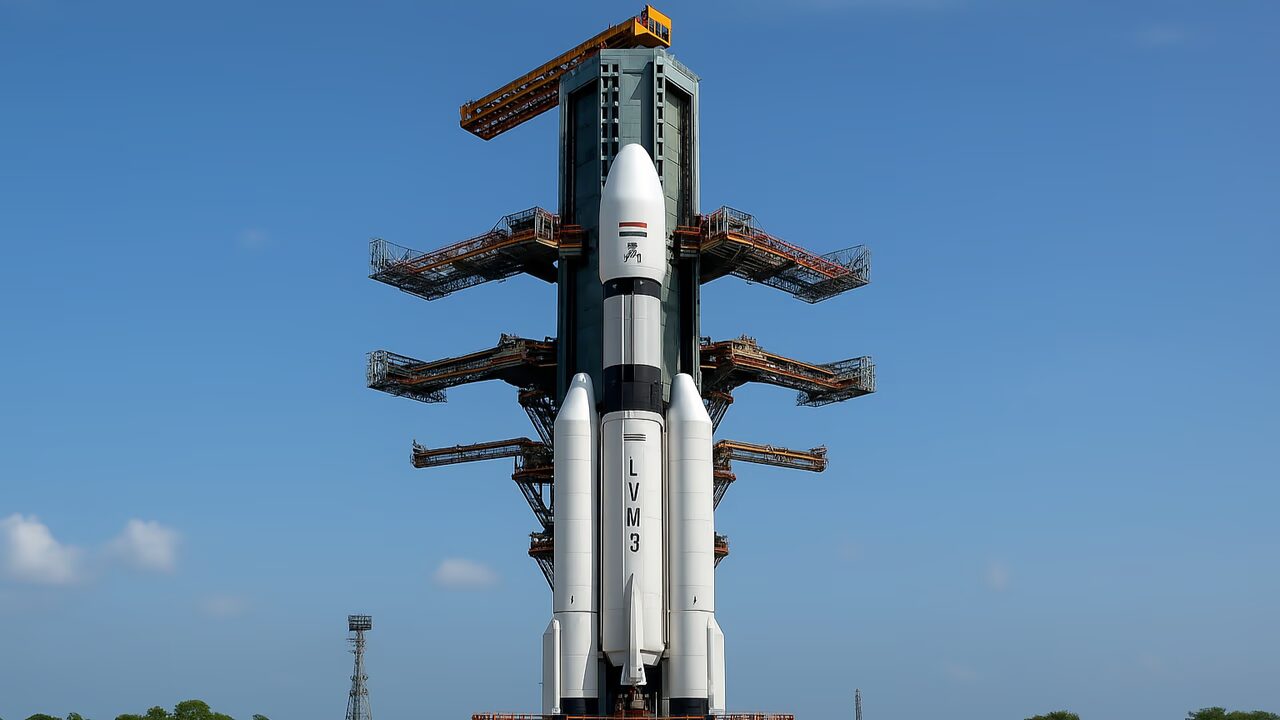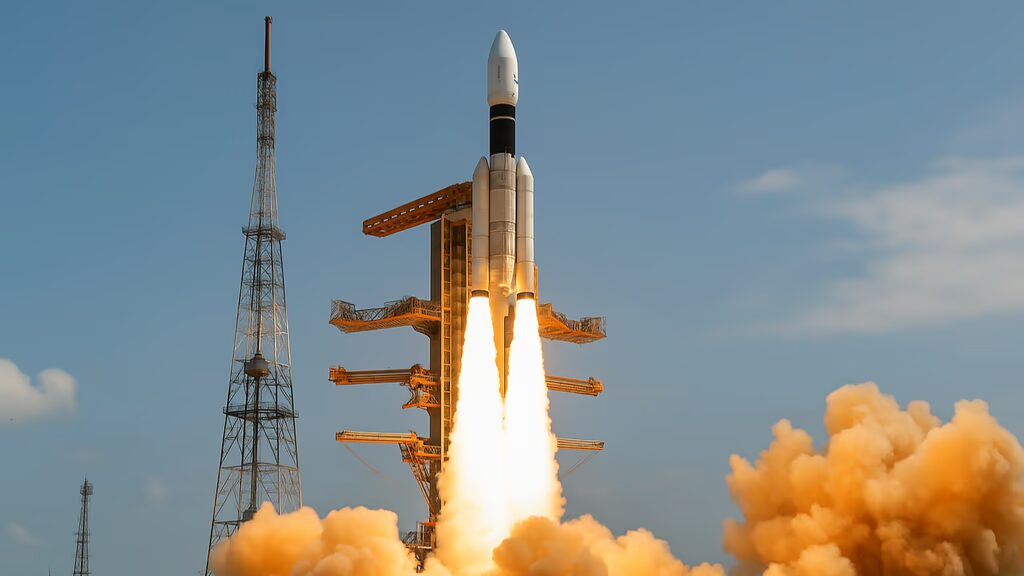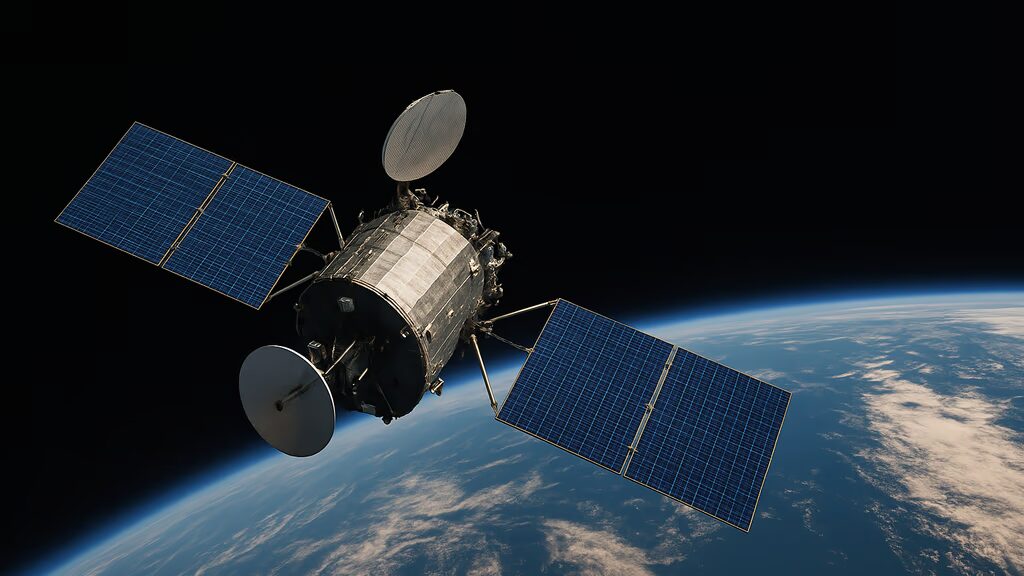
With the successful launch of GSAT-7R (CMS-03), India has set yet another landmark in space and defence technology. The satellite was launched aboard the LVM3-M5 (Launch Vehicle Mark-3), India’s heaviest and most advanced operational rocket, from the Satish Dhawan Space Centre (SDSC) in Sriharikota, Andhra Pradesh.
This landmark mission will enhance India’s strategic space communication network and constitute yet another giant leap toward Aatmanirbhar Bharat in defence and aerospace capabilities.
ALSO READ- Interstellar Comet 3I/ATLAS Live Tracker: When & How to Watch
The Launch-
The GSAT-7R (CMS-03) satellite was launched at 5:26 PM IST on Nov 2, 2025, from the first launch pad at Sriharikota. The mission, in turn, aimed to put the 4,400 kg multi-band communication satellite into a Geosynchronous Transfer Orbit (GTO), from where it will later move to its final Geostationary Orbit (GEO) at a height of around 35,786 kilometres above the equator of the Earth.
LVM3 Rocket-
The newly termed Launch Vehicle Mark-3 (LVM3), which is previously known as GSLV Mk-III, is India’s mightiest launch vehicle, with a payload carrying capacity reaching 4,000 kg to Geostationary Orbit. It has served missions such as the launch of Chandrayaan-3, with India emerging as the first nation to successfully land near the Moon’s south pole.

Key Features of LVM3:
It consists of three stages for a heavy-lift launch vehicle.
- The total height is 43.5 meters.
- The mass will be approximately 640 tons during liftoff.
- Its capacity loads include up to 4,000 kg to GTO and 10,000 kg to Low Earth Orbit.
Stages of LVM3:
- The first stage is the solid stage: Two large solid strap-on boosters provide the initial thrust necessary for lift-off.
- The second stage is the liquid stage: The core liquid stage uses unsymmetrical dimethylhydrazine (UDMH) as fuel and nitrogen tetroxide (N₂O₄) as oxidiser.
- The third stage is the cryogenic stage: The upper stage is powered by a CE-20 cryogenic engine indigenously developed by ISRO and uses liquid hydrogen (LH₂) and liquid oxygen (LOX) as propellants, which give it high space efficiency.
This configuration has made LVM3 the backbone of India’s heavy-lift missions, performing interplanetary and human spaceflight programs.
ALSO READ- End of Kafala System in Saudi Arabia: A New Era for Indian Immigrants
About GSAT-7R (CMS-03)-
The GSAT-7R (CMS-03) is one of the advanced series of India’s defence communication satellites, which are especially meant for military communications in a secure and high-capacity mode. It enhances the already-proven capabilities of other GSAT-7 satellites with a larger coverage area and advanced communication systems.

Key Features:
- Weight: About 4,400 kg
- Orbit Type: Geostationary
- Frequency Bands: C, Extended C, and Ku bands
- Coverage Area: Entire Indian mainland and the whole Indian Ocean Region
- Operational Life: Estimated 10-12 years
Main Objectives:
- For increasing secure communications between ships, submarines, aircraft and coastal command centres of the Indian Navy.
- To enhance maritime domain awareness in respect of the Indian Ocean Region.
- To improve communication, bandwidth is strategic for defences as well as civilians to some extent.
- To support network-centric warfare capabilities to ensure real-time coordination among the different services of the armed forces.
- The satellite has state-of-the-art transponders to facilitate voice, data and video links that allow redundant and encrypted communication across wide areas.
Significance of the Mission-
Enhancing Defence Communication:
The GSAT-7R would be the dedicated communication satellite for the Indian Navy, which will enable communications under hostile or inaccessible conditions. This strengthens India’s blue-water naval capabilities, indispensable for surveillance and strategic missions.
A Giant Leap Towards Self-Reliance:
Developed in India by ISRO, the mission represents the manifesto of India in Aatmanirbhar Bharat for defence and space technology. It will become less dependent on foreign satellites for safe communication.
Support for Modern Warfare:
Real-time communication is necessary on the modern battlefield. GSAT-7R will also facilitate precision targeting, missile guidance, and situational awareness, thereby maturing India’s defence.
Broader Benefits to the Citizenry:
While it is aimed at the defence sector, CMS-03 will provide high-capacity bandwidth that will indirectly assist civilian communication, disaster management, and remote area connectivity.
Expanding the Strategic Reach of India:
The GSAT-7R communication footprint stretches over the Indian Ocean, thus providing India with a strategic advantage in giving defence surveillance cover and humanitarian operations.
ALSO READ- A New Moon of Earth? 2025 PN7 Explained
India’s Defence Communication Network-
India’s military communication system relies entirely on the GSAT-7 series, applicable to all three armed forces:
- GSAT-7 (Rukmini): Operational since 2013, to provide communications and maritime surveillance capabilities to the Indian Navy.
- GSAT-7A (Angry Bird): Launched in 2018 to provide support to network-centric operations and UAV communications of the Indian Air Force.
- GSAT-7B: Under development, this satellite is meant to reinforce communications for the Army, especially in terms of coverage in high-altitude and border-rugged areas.
- GSAT-7C: Also in the making, this will create secure ground hubs for real-time encrypted communication amidst all three services.
Through GSAT-7R (CMS-03), India is on its last leg towards achieving a tri-services unified communication. Integrated among the Navy, Air Force, and Army into one secure platform.
LVM3: India’s Heavy-Lift Future-
The LVM3 is not only India’s advancement in technology but also a symbol of reliability. Apart from launching national defence satellites, it also gained a reputation for international commercial and specific scientific missions.
- Chandrayaan-3 (2023): It enabled India’s soft landing near the Moon’s south pole.
- OneWeb Launches: Delivered more than 70 international satellites, heralding ISRO’s capability to launch globally.
- Gaganyaan Mission: It will soon carry Indian astronauts to space as part of demonstrating its human spaceflight potential.
From these achievements, LVM3 is critical to future ISRO programmes that will include interplanetary explorations, commercial payload launches, and strategic satellite deployments.
Future Prospects-
CMS-03 is only a small step in India’s increasing space vision. Future missions like GSAT-7B, GSAT-7C, and secure Quantum Communication satellites will provide increasingly secure and resilient communications for defence and national governance.
The upcoming NISAR mission of ISRO in collaboration with NASA, plus the Gaganyaan human spaceflight program, all give credence to the increasing stature of the agency across the globe.
The success of CMS-03 reinforces ISRO’s capabilities in realising missions that are complex, high-value, and executed with indigenous technology and precision.
Conclusion-
The successful launch of GSAT-7R (CMS-03) aboard the LVM3-M5 rocket clearly demonstrates the progress made by India in space technology and defence preparedness. This mission secures communication for naval and strategic forces and strengthens India’s maritime security and technological sovereignty.
As ISRO continues with this mission of transformation and innovation, CMS-03 is yet another reminder of India’s growing presence in global space exploration, self-sufficient defence infrastructure, and satellite technology, proudly taking the spirit of “Make in India” to the extraterrestrial realm.
FAQs-
GSAT-7R, otherwise called CMS-03, was an advanced communication satellite with multi-band secure communication links for the armed forces of India, offering special services to the Navy.
The satellite was launched into orbit by LVM3-M5, India’s heaviest and most reliable rocket, especially made for launching bigger payloads.
It helps to secure defence communications, strengthen surveillance, sustain near-real-time maritime operations, and augment India’s strategic autonomy over space communication.
Enabling instantaneous encrypted communications among naval warships, submarines, aircraft, and command centres is thus very critical for strategic coordination and maritime domain awareness.
The satellite is expected to remain operational for anywhere between 10 and 12 years, subject to in-orbit conditions.
Yes, indirectly. Its improved bandwidth can cater to disaster response and remote connectivity applications, other than its defence usage.
